This is worse than those weekly cliffhanger serials that used to be popular, both because it’s taking longer than a week for me to get to the next installment, and because it’s nowhere near as interesting…
The morning after the storm photos at the lighthouse, I was up early to catch the sunrise, but was delayed a bit because I had to change out the leaking tire. Since the Earth flatly (um, globally) refused to refrain from spinning as I did this, I had a very short period of time to be someplace and ready for the sunrise, so I settled for a beach access just south of Avon, the town I was staying in. If you’ve looked at the map at all or are otherwise familiar with the Outer Banks, it comes as no surprise that they’re flat; also rather thin on trees and such. This means that the options for scenic compositions are limited – no shooting from hills, few items to do foreground interest, and so on. I simply picked a nice spot on the side of the dune break that allowed beach access and set up the tripod there. Luckily, the sun cooperated much better than the night before, and I captured some nice colors and textures as the sky lightened.
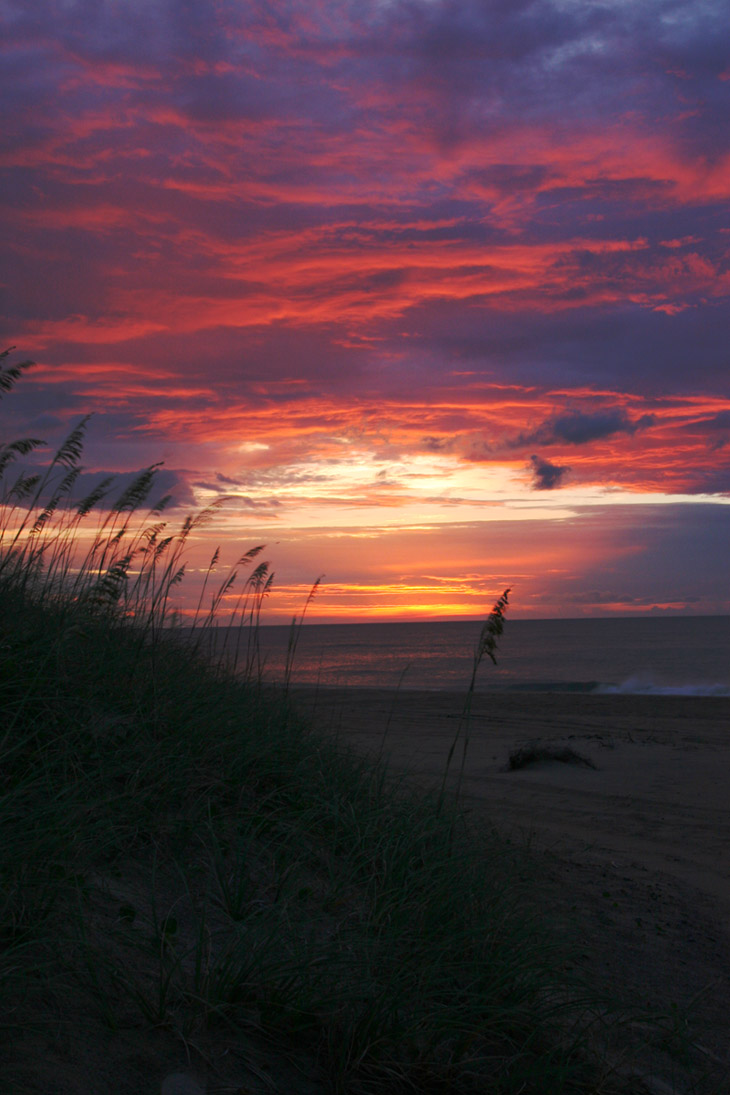
A little tip: these are the kind of conditions where you bracket heavily, not trusting the exposure meter at all, but shooting a lot of frames both over- and under-exposed to get the best colors. Not only is it necessary because the frame might contain a wide range of light levels – as seen here – but because the shutter speed will be different for those exposures too, and might freeze a crashing wave in place, or allow for some movement from the breakers that produces a surreal cottony look. It will also give you the option to do some high dynamic range work if you want to composite together an image that has a decent exposure for both the foreground and the sky (the image above is not an example of this, but exactly as it was shot in-camera.)
Also note that the sun will illuminate the clouds progressively further up as it rises, perhaps turning the slate-grey surfaces pink or orange in stages, and this can be extremely subtle – we tend to watch the horizon in such cases and ignore the view above our heads, so keep looking around and shooting a lot of frames.
As the sun made its appearance, it was framed against some distant cumulus clouds which lent a bit of interest to the scene, and I went in close for a sequence of frames as it rose.

The sun (and moon) move their own width in 150 seconds, so from first peek to fully above the horizon takes less than three minutes, though atmospheric distortion may alter this slightly – in the right conditions the sun can actually be seen to us even when it is technically below the horizon, the light being bent by the oblique angle through the atmosphere. This is also what produces the out-of-round appearance vaguely visible here. Those clouds were a long ways off, being almost entirely over the horizon, and knowing how high they tend to be, they could have been well over a hundred kilometers distant – there’s even the chance that they were the same storm that I’d been shooting, and driven back in, the night before.
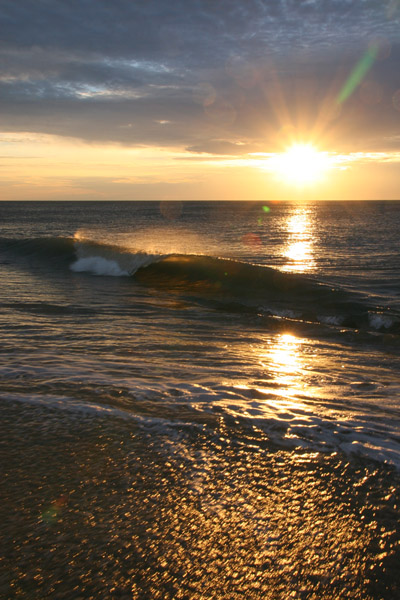 Soon afterward, the sun rose into that line that can be seen over it, in the photo above, which was another solid wall of clouds – at that point the conditions sank back into hazy twilight. I waited around a bit, and was rewarded by the occasional appearance that let me do some more moody breaker photos. For unknown reasons, the birds were particularly sparse on this trip – I did not see one pelican at all – and so the ‘typical’ beach wildlife shots weren’t part of the gallery this time around. Even the occasional seagull or tern was framed against darker clouds and lower light conditions, making it hard to freeze them in midair since the shutter speeds went a little too long to allow this – you’ve seen perhaps the best example in the previous post.
Soon afterward, the sun rose into that line that can be seen over it, in the photo above, which was another solid wall of clouds – at that point the conditions sank back into hazy twilight. I waited around a bit, and was rewarded by the occasional appearance that let me do some more moody breaker photos. For unknown reasons, the birds were particularly sparse on this trip – I did not see one pelican at all – and so the ‘typical’ beach wildlife shots weren’t part of the gallery this time around. Even the occasional seagull or tern was framed against darker clouds and lower light conditions, making it hard to freeze them in midair since the shutter speeds went a little too long to allow this – you’ve seen perhaps the best example in the previous post.
By the way, for those still following along at home, this is the placemark that illustrates my shooting location for this sunrise – clicking it should automatically open Google Earth if you have it installed on your computer.
But of course, early morning on the beach almost always means crabs. The Atlantic ghost crab (Ocypode quadrata) is aptly named, since one usually catches only a fleeting glimpse of them as they scurry back into their burrows upon someone’s approach, sparking the realization that they were right there but we never saw them. Their camouflage is among the best I’ve seen (or at least, realized that I’ve seen) in North American species, blending into the sand extraordinarily well, but with a little practice and alert eyes, they can be spotted at least when they pause after fleeing, usually from having wandered too far from their burrow and being unable to find shelter. It is very bad news to use another crab’s burrow, by the way, so it’s important to find the right one, and I got lucky enough to get between a young crab and its safe haven, allowing me to get several nice close images.
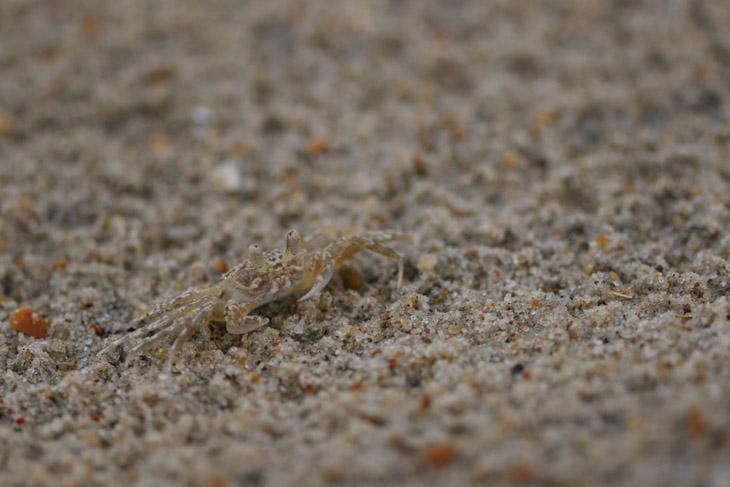
It’s much worse in hazy conditions, because the crabs won’t even throw a shadow that can help them stand out – and they seem to realize this, rarely being out in full sunlight. They are, of course, considered a tasty treat by most sea birds and probably just about anything else in the area, and are mostly nocturnal – going out on the beach at night with a flashlight makes it much easier to spot them, and the light tends to mask your approach too, so it’s easier to get close. I used natural light for the image above, just to show how hard it is to see them, but opted for a flash for the next pic, showing the details of shape and camouflage a little better.

This produces much the same results as using a flashlight at night would, providing a distinctive shadow that helps pick them out against/above the sand, but even this close the coloration and camouflage pattern is impressive. This one was quite small, perhaps 3cm across the entire width, and once it realized it could not reach its burrow it simply froze in place, though if I moved too sharply it would dash away a short distance before freezing again; if I wasn’t watching when this occurred, it was difficult to find the crab again even though it was still within two meters.
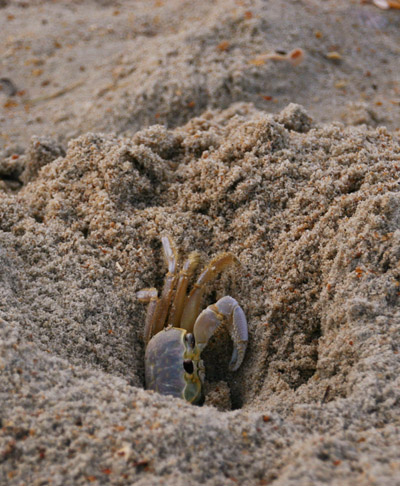 As they get larger, the camo pattern fades, perhaps because they’re faster and more adept at escaping, and also maybe because they’re no longer good targets, in size and defensiveness, for predators. I spotted one ducking into a larger burrow as I approached, and sat down to wait it out, which doesn’t take too long.
As they get larger, the camo pattern fades, perhaps because they’re faster and more adept at escaping, and also maybe because they’re no longer good targets, in size and defensiveness, for predators. I spotted one ducking into a larger burrow as I approached, and sat down to wait it out, which doesn’t take too long.
This one seemed to have a good memory for what the landscape looked like, because its first peek out after I took up a nearby position caused it to immediately withdraw back into its burrow, despite the fact that I was motionless; I’ve grown so used to species that pay no attention as long as I’m not moving that I’m slightly surprised by those that can recognize what ‘doesn’t belong.’ However, this is a relative thing – by the time it peeked out again and I still hadn’t moved from position, it determined that the coast was clear (sorry) and continued with its business, which was to clear out the warren from the wash-in caused by the night’s rain. That’s the mound of fresh sand that you see here above the opening.
 This one was about 4cm across the carapace, so not quite a hand-span in overall width, and I wasn’t shooting with a long focal length for this at all; just a little out of the frame at bottom were my crossed legs. The crab dragged up a load of sand tucked into its legs and pincers, moving cautiously but not particularly slowly, and since I’d been sitting with the camera already raised to my eye it was easy enough to get a sequence of frames. Now, the camera isn’t particularly heavy (though I think I still had the flash attached,) but when you have to sit perfectly still in ready position and wait for something to happen, you quickly realize how fatiguing this can be. I could have spent some time building myself a nice comfortable lounge chair out of sand, but by then the sun would have been too high and the crabs would have called it a day. Maybe next trip.
This one was about 4cm across the carapace, so not quite a hand-span in overall width, and I wasn’t shooting with a long focal length for this at all; just a little out of the frame at bottom were my crossed legs. The crab dragged up a load of sand tucked into its legs and pincers, moving cautiously but not particularly slowly, and since I’d been sitting with the camera already raised to my eye it was easy enough to get a sequence of frames. Now, the camera isn’t particularly heavy (though I think I still had the flash attached,) but when you have to sit perfectly still in ready position and wait for something to happen, you quickly realize how fatiguing this can be. I could have spent some time building myself a nice comfortable lounge chair out of sand, but by then the sun would have been too high and the crabs would have called it a day. Maybe next trip.
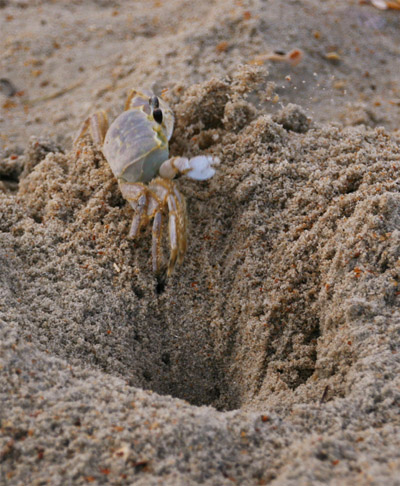 My timing was right on this one: if you look closely at upper right, you can actually see sand in midair that the crab was flinging away. As soon as this action takes place the crab typically shoots back into the burrow, instinctively aware that the motion attracts attention. This makes me wonder what purpose is served by hurling the sand away rather than simply depositing it subtly, which would be a lot harder to see, but I’ve watched this behavior from numerous specimens so it seems to be typical.
My timing was right on this one: if you look closely at upper right, you can actually see sand in midair that the crab was flinging away. As soon as this action takes place the crab typically shoots back into the burrow, instinctively aware that the motion attracts attention. This makes me wonder what purpose is served by hurling the sand away rather than simply depositing it subtly, which would be a lot harder to see, but I’ve watched this behavior from numerous specimens so it seems to be typical.
Eventually, I packed it up and went back to my room to check out and head back north. I would have spent a lot more time poking around in the southern reaches of the Outer Banks, perhaps even taking the ferry to Ocracoke, but I had to get the tire repaired and it seemed the only places that could tackle that were in the Nags Head area. Unfortunately, this exposed me once again to horrendous traffic (it was Saturday morning, the week following Independence Day) and my mood was deteriorating rapidly. I was going to go for a swim while the tire was being repaired, but before I even got to the beach access I got called back by the shop, informed that the tire couldn’t be patched and needed to be replaced instead. The combination of additional expense, detouring north, and mounting irritation caused me to cut the trip shorter than intended, and I pretty much wrapped it up once the new tire was mounted – I did a brief stop chasing some scenic pics on the way back (and a nap in the car to counteract the road fatigue and short sleep hours the previous night,) but that was it. While I can’t complain about the images I captured – which I have yet to finish sorting – I’d still intended for the trip to have more in it, so I retain the impression that it didn’t accomplish much. It’s nothing but perspective, really – humans are weird that way. Or maybe it’s just me.




















































